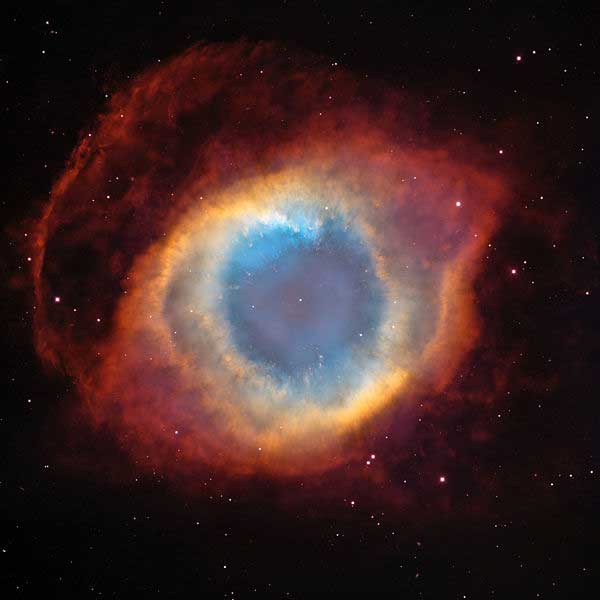
Visible light image of the Helix Nebula, compiled from Hubble telescope and ground-based images in 2004.
The Helix Nebula (also known as NGC 7293) is a planetary nebula (PN) about 650 light-years away in the constellation Aquarius. It is one of the closest planetary nebulae to Earth[4] and was discovered by Karl Ludwig Harding before 1824. It has a very similar appearance to the Ring Nebula. It is also similar in size, age, and physical characteristics to the Dumbbell Nebula, with the significant difference in appearance being a consequence of the relative proximity and more nearly equatorial viewing angle of the Dumbbell.[2] The Helix has often been referred to as the Eye of God on the Internet, since about 2003[5]. The Helix Nebula was also featured in the 2004 Battlestar Galactica TV series.
Observation data
(Epoch J2000)
Right ascension 22h 29m 38.55s[1]
Declination -20° 50′ 13.6″[1]
Distance 680+150−80 ly (207+46−24 pc)[2]
Apparent magnitude (V) +13.5[1]
Apparent dimensions (V) 25′[3]
Constellation Aquarius
Physical characteristics
Radius 2.87 ly (0.88 pc)[3]
Absolute magnitude (V) 6.58[a]
Notable features One of nearest PNs
Other designations NGC 7293[1]
General information
The Helix Nebula is an example of a planetary nebula created at the end of the life of a Sun-like star. The outer gases of the star expelled into space appear from our vantage point as if we are looking down a helix. The remnant central stellar core, destined to become a white dwarf star, glows in light so energetic that it causes the previously expelled gas to fluoresce.
Helix lies about 650 light-years away towards the constellation of Aquarius and spans about 2.5 light-years. Recent pictures of Helix are a composite of newly released images from the ACS instrument on the Hubble Space Telescope and wide-angle images from the Mosaic Camera on the WIYN 0.9 m Telescope at Kitt Peak National Observatory.
It is estimated to be 10,600+2,300−1,200 years old based upon an expansion rate of 31 km/s.[2]
Structure
The nebula is thought to be shaped like a prolate spheroid with a strong density concentration toward a filled disk of the equatorial plane. Its major axis is inclined about 21° to 37° from our vantage point. It is composed of an inner disc with a 8′ 19″ diameter (0.52 pc) and outer torus with a 12′ 22″ diameter (0.77 pc) and an outer-most ring with a 25′ diameter (1.76 pc). The outer-most ring is flattened on one side due to its colliding with the ambient interstellar medium. The PN is estimated to have been expanding for 6,560 years for the inner disc and 12,100 years for the outer ring with expansion rates of 40 km/s and 32 km/s respectively.
Knots
The Helix Nebula was the first PN discovered to contain knots. The main ring contains knots of nebulosity which have now been detected in many near-by PNs. In the Helix, these knots are highly radially symmetric (from the central star) and "cometary", they contain bright cusps (local photoionization fronts) and tails which extend away from the star in the radial direction. At the cusps the knots are optically thick to Lyc photons from the central star.[2][3][6]

Infrared image of the Helix Nebula, taken by the Spitzer space telescope, 2007
See also
* New General Catalogue (NGC)
* Ring Nebula
Notes
1. ^ 13.5 apparent magnitude - 5 * (log10(242 pc distance) - 1) = 6.58 absolute magnitude
References
1. ^ a b c d SIMBAD Astronomical Database. Results for Helix Nebula. Retrieved on 2006-12-07.
2. ^ a b c d O'Dell, C. R.; Balick, B.; Hajian, A. R.; Henney, W. J.; Burkert, A. (2002). "Knots in Nearby Planetary Nebulae". The Astronomical Journal 123 (6): 3329-3347.
3. ^ a b c O'Dell, C. R.; McCullough, Peter R.; Meixner, Margaret (2004). "Unraveling the Helix Nebula: Its Structure and Knots". The Astronomical Journal 128 (5): 2339-2356.
4. ^ Hora, Joseph L.; Latter, William B.; Smith, Howard A.; Marengo, Massimo (2006). "Infrared Observations of the Helix Planetary Nebula". The Astrophysical Journal 652 (1): 426-441.
5. ^ Urban Legends Reference Pages. The Eye of God. Retrieved on 2007-07-16.
6. ^ O'dell, C. R.; Balick, B.; Hajian, A. R.; Henney, W. J.; Burkert, A. (2003). "Knots in Planetary Nebulae". Winds, Bubbles, and Explosions: a conference to honor John Dyson, Pátzcuaro, Michoacán, México, September 9-13, 2002 (Eds. S. J. Arthur & W. J. Henney) Revista Mexicana de Astronomía y Astrofísica (Serie de Conferencias) (http://www.astroscu.unam.mx/~rmaa/) 15: 29-33.
Retrieved from "http://en.wikipedia.org/"
All text is available under the terms of the GNU Free Documentation License

